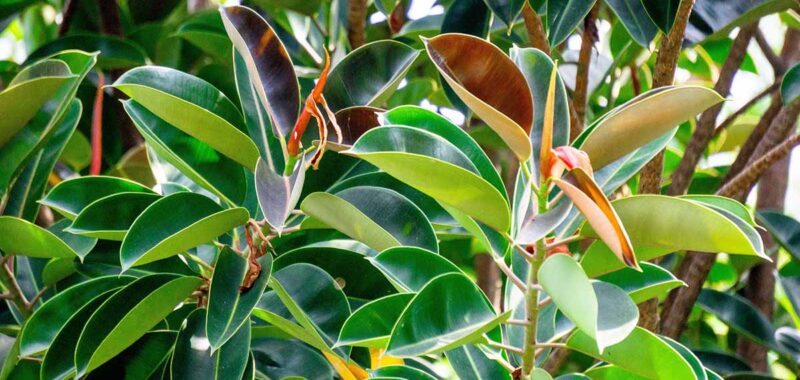In their natural environment, rubber trees, Ficus elastica, can grow over 100 feet tall.
They will never grow anywhere near that large when grown as houseplants, but that doesn’t mean they can’t use some shaping and containment now and then.
Pruning can give an outdoor tree some shape or you can help encourage branching in a houseplant that has grown a bit leggy.


We link to vendors to help you find relevant products. If you buy from one of our links, we may earn a commission.
The process of pruning allows you to remove any sick or damaged branches, or regenerate a rubber fig that has been neglected. So no matter the size or condition of your plant, a little trimming might be in order.
Our guide to growing rubber trees has all the info you need to cultivate these impressive plants in your home.
In this guide, we’re going to focus on pruning for health and appearance.
Here are the topics we’ll cover:
How to Prune Rubber Trees
Before we talk about the process, you might be curious why you should be trimming in the first place. Here’s why:
Why Prune Rubber Trees?
You don’t have to prune F. elastica, these plants can go years without any trimming and will be just fine.


When grown indoors, rubber trees can become leggy, with long stretches of stems or branches that lack foliage.
If you want to make your plant bushier, pruning it back can encourage branching and new foliar growth to fill in those bare areas.
You can also prune to keep the F. elastica at a manageable size in your home or yard.
Apart from pruning for size, trimming away any branches that are diseased, infested by pests, deformed, or broken, is helpful to keep the plant healthy and looking its best.
Preparation
Before you get started, you’ll need to choose a suitable pruning tool.
A pair of secateurs, like the Felco F-2, is perfect for houseplants or moderate size outdoor specimens. For larger trees you may need loppers or a tree pruner.


You’ll also need to wear gloves and a long-sleeved shirt, as rubber figs exude sap that can be highly irritating to your skin.
If the plant you’re working with is very tall and you’ll be working overhead, wear protective goggles and avoid standing directly underneath where you are making your cuts.
When you’ve chosen your pruning tool, you need to clean it thoroughly before use.
If you don’t clean your tools, you run the risk of spreading pests and disease, and the last thing you want is to infect your newly trimmed tree.


I use a 10 percent bleach solution (one part bleach to nine parts water) to wipe down my tools.
In addition, grab some isopropyl alcohol and keep it handy while you work, because the sap can gum up your tool and you will need to wipe it down regularly between cuts.
When to Work
If you are growing your F. elastica indoors, you can prune whenever you wish.
However, both for indoor and outdoor specimens, winter is best because the plant is dormant during this time.
Or rather, as is the case with many tropical evergreens, it’s in a semi-dormant state during the colder months.


It is best to prune when plants are dormant for a number of reasons.
Pathogens and pests are usually less of a problem than during the growing season and the plant is less likely to be traumatized by the work you’re doing.
Having said that, if you notice diseased or pest-infested branches that need to go, cut those off whenever you see them.
The other exception is if you are trimming solely to encourage branching. This can be done whenever the plant is actively growing.
How to Prune
Before you make the first cut, look closely at your plant and identify the leaf nodes. These are little bumps where the leaves emerge from the stem.
You want to make all of your cuts about a quarter of an inch above these leaf nodes and at a slight angle so any water runs off of it rather than remaining in place and attracting pathogens.


Start by removing any stems or leaves that are diseased, damaged, infested with pests, as well as any branches rubbing against each other.
When you’ve trimmed off any that can’t be saved, step back and look at the plant, noting any areas that are looking leggy or lacking in foliage.
If there is an area that is thin, cut the branch slightly below that area so the new growth grows up into and fills it in. If you want to encourage outward, bushy growth, cut the top off of the stems.


Make any additional cuts you need to give the plant the shape you want.
Never remove more than a third or so of the plant at a time. You want to leave enough foliage behind that the plant can still photosynthesize and grow.
Shape Up!
Most plants need pruning to some degree. With rubber figs, it’s about providing some shape and maintaining their health.
I’m always surprised after I do a little pruning at how much better my plants look. It’s like I get used to their imperfection and don’t realize how pretty they can be with some extra care.


What’s your motivation for pruning? Is your plant a little leggy or sick? Are you trying to create a different shape? Let us know the details in the comments section below.
And for more information about growing and caring for rubber trees, check out these guides next:


